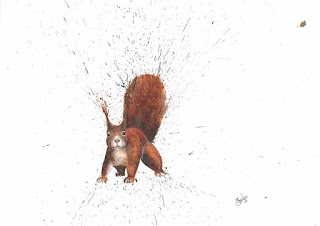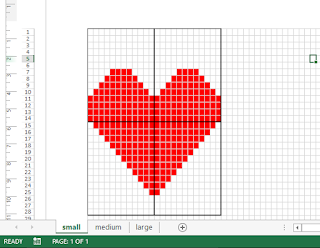Hi there, Everyone!
I hope you've had a great week and are looking forward to some crafty time this weekend. It can be really hard to carve out some time for yourself in amongst the chores and other demands on you, but nourishing activities such as crafting can be fabulous for your well-being. I know I'm a much nicer person to be around if I can escape for even half an hour. I love to try new ideas and techniques but find myself reaching for the old faithfuls when I'm pushed for time, as it takes a while to get hold of something new. These tutorials are designed to make it easier for you to try something out and should help you make the most of your precious time. I'd love to hear your thoughts: enjoy!
What are relief motifs?
Relief motifs are images worked into stocking stitch pieces. The advantages are that they are subtle (no gaudy snowmen here!) and also worked in the same yarn as the main piece, allowing you to avoid the fiddly weaving of ends and working with two or three yarns simultaneously.
How did I come up with the idea?
Firstly, it turns out that this is not a wholly original idea. There are fabulous examples of this sort of motif on Pinterest, so I can't claim credit for it. However, the idea of using this style of motif to jazz up plain stocking stitch came about when I was creating the Tooth Fairy Pillows.
The first Tooth Fairy Pillow was worked in stocking stitch for the front, then plain garter stitch for the reverse. It was functional and the self-patterning yarn I'd used for the front was effective, but it lacked a certain pzazz. I knew I didn't want to over complicate it with cables or intarsia (tutorial coming soon) but I needed an effective way to create child-pleasing images and add interest to the plain little pillows.
Deep in thought, I absent-mindedly fiddled with the beautiful cabled throw my mother had made for me. I must have sat there for about half an hour puzzling over it, when I realised that the answer was on my lap the whole time!
As you can see from this shot of the throw "in progress", the cables are worked using purl and knit stitches. The knit stitches "pop" forwards, throwing the background into relief. While cable itself was too fussy for my Tooth Fairy Pillows, I realised that I could use the "popping" effect to create images within stocking stitch.
I set to work and, after a lot of trial and error, the first pillow was complete:
So it really is that simple: use the opposite stitch (purl to knit / knit to purl) to create a raised or indented design. What does take time, however, is the planning out of your design, and this tutorial will take you through the steps to designing on Excel. You can of course do this on graph paper, just ensure you do step 1 first!
STEP 1: Check your tension
I know, I'm sorry: I hate tension squares too. In fact, I usually don't bother with them (cue gasps of horror from seasoned knitters) but they are essential for when it comes to adapting and personalising a plain project. This is because your design will be worked out in rows, so you need to know how many rows to however many inches you're planning on using. A typical pattern will give you an instruction like this:
Working in stst throughout, continue without shaping until work measures x cms
Now for someone with loose tension like me, that could mean x number of rows, but for someone with a tighter tension like my mother, it would mean y number of rows: therefore, our individual motif designs would require different numbers of rows. I hope that isn't too confusing!
So, if you're working on a project with a pattern, grab your specified yarn and needles and get to making a plain stocking-stitch tension square. The pattern will usually specify how many stitches and rows they expect you to need to create a 10x10cm square. For example, the one I've got to hand says:
Tension: 22sts and 28 rows to 10cm (4in) over stocking stitch on 4mm needles or the size required to give correct tension.
What this basically means is that, for a fitted garment (width is very important and rows specify number of stitches) they want you to need 22sts per 10cm width. My tension used to give me about 12cm for 22st so I'd have to swap my needles down a size to 3.75mm. My grandmother, on the other hand, knits very tightly so needs to swap up a size.
But what if I don't have a pattern?
If you're going completely off-piste as I did and creating your own project from scratch, this is a handy
guide to general tensions for the various yarn weights. Typically DK yarn should be 22-24st and 24-28 rows to 10cm on 4mm needles (US size 8). As long as you know how many rows you take to 10cm, you're cool.
STEP 2: Using Excel to Create your Design
Now, please accept my apologies if you're already a whizz with technology but speaking as someone who is definitely not technologically whizzy (this is my second go at writing this blog post as somehow I've managed to delete the draft!), I find it useful to have everything spelled out for me so that is what I will do here.
First, open up Excel: you should get a home page showing up like this:
If you don't, then simply click "open" and "new" from the main menu on Excel. Then, your next step is to type in "graph paper" into the "search for online templates" box at the top of the screen.
As you can see, this has brought up some designs that Excel thinks fits the bill. I personally chose the first one and as it happens, it's produced by Microsoft, so it's pretty reliable.
Then, on the document that you open, you'll need to identify your design space. For me this was 24 sts and 28 rows.
Having selected your working area, click on borders and choose "outside borders".
This will now give you a clearly defined working area.
Next, find your centre. I'm sure there is a more efficient way to do this but I highlight a quarter of the working area at a time and select "outside borders" for each one. It's a little time consuming but makes life a lot easier!
Now you're ready to work. Let's start with a basic heart motif:
All you do for this is select the cells (squares) you want to create your design in and choose this button from the toolbar:
That done, you can design your motif in colour. We're not going to change colour when we knit it, but it makes it easier to see and design.
The reason for designing on something like Excel (or good old graph paper) is that there's a lot of trial and error involved. In fact, even with designing in this way, you'll probably find that you undo your work at least twice to make slight adjustments to your design. Designing first reduces the number of times you may find yourself undoing and redoing your work, which is better for the yarn as being overworked can make it thinner or bobbled and it's harder to maintain tension. Your stitches can also become twisted if you pick them up incorrectly once you've ripped your work back.
For example, I've created a heart motif before, but still hand to design twice on Excel for this blog:
a)
As you can see, this heart is sweet and in perfect proportion. However, I'd decided I wanted a 10x10 design and this is only 5x6. In addition, it's not centred. I needed to make it bigger, and also centre it.
b)
This heart is larger and will be more in keeping with my project, but it looks very pointy and a little unfriendly at the top: it needs softening and centring.
c)
This heart is much better as I've softened off the edges and it's still a better height. I may work it up once and decide it needs reworking again owing to overall scale, but I'm happy with the design. The only thing left to do is to centre it by moving it up two squares (rows).
Again, there are probably simpler ways to do this but I chose to remove the borders and then reinstate them two rows lower than I had before, so now the heart is as close to centre as it could be.
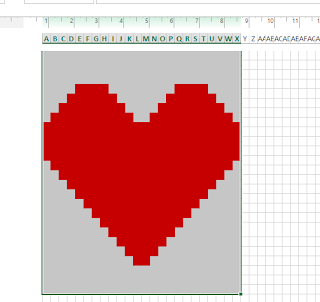 |
| First, select your whole design area. |
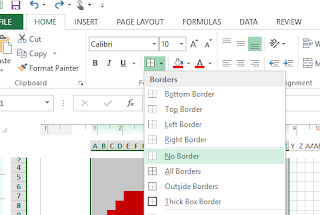 |
| Then choose "no border" |
 |
| Select an area two rows below (or however many required to centre your design) where it was before. |
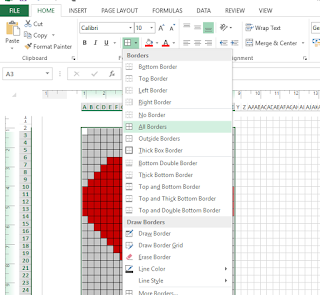 |
| Choose "all borders" |
 |
| Then, in the same way as we did to find our centres originally, select a quarter of your working area at a time and choose "thick outside border". Repeat for all four quarters. |
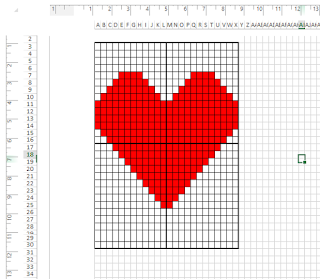 |
Et voila!
|
What if I want to create a more technical design?
Really, it's all up to your imagination! I would advise against using single knit stitches and single purl rows as your motif will lose definition. An example of this going wrong is with my Sailboat motif:
Now, at first glance, this might seem like a perfectly feasible design. However, there are some serious problems with it. While it's pretty much bang on centre (it's an odd number of rows so it won't be quite perfect), I've had to use knit stitches for the base of the mast, then leave it as purl stitches in order to define it from the sails either side. In addition, I've only left 1 row of purl stitches between the hull of the boat and the sails themselves. While it looks great on paper, in practice there was no definition and you had to really squint to see what it was I'd tried to create. As my rows were shorter than my stitches were wide, it also ended up quite squat: all of these are great reasons for doing your tension square and planning out your design first.
Once you've created some designs successfully, you can become more adventurous. Here are some of my favourites from around the web. I've included links to their blogs in the captions.






